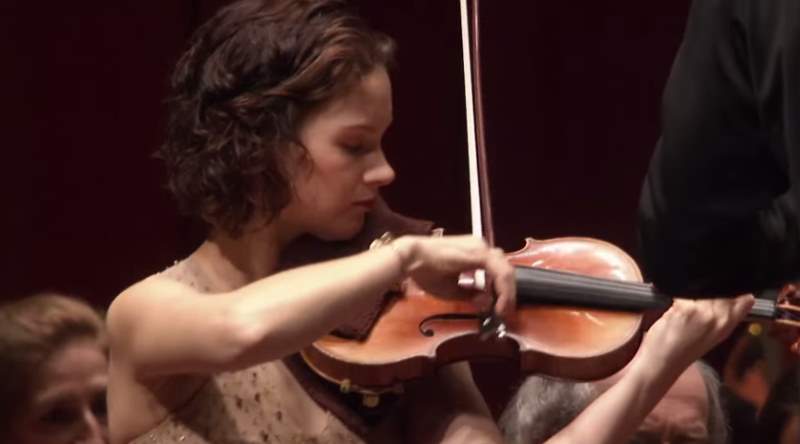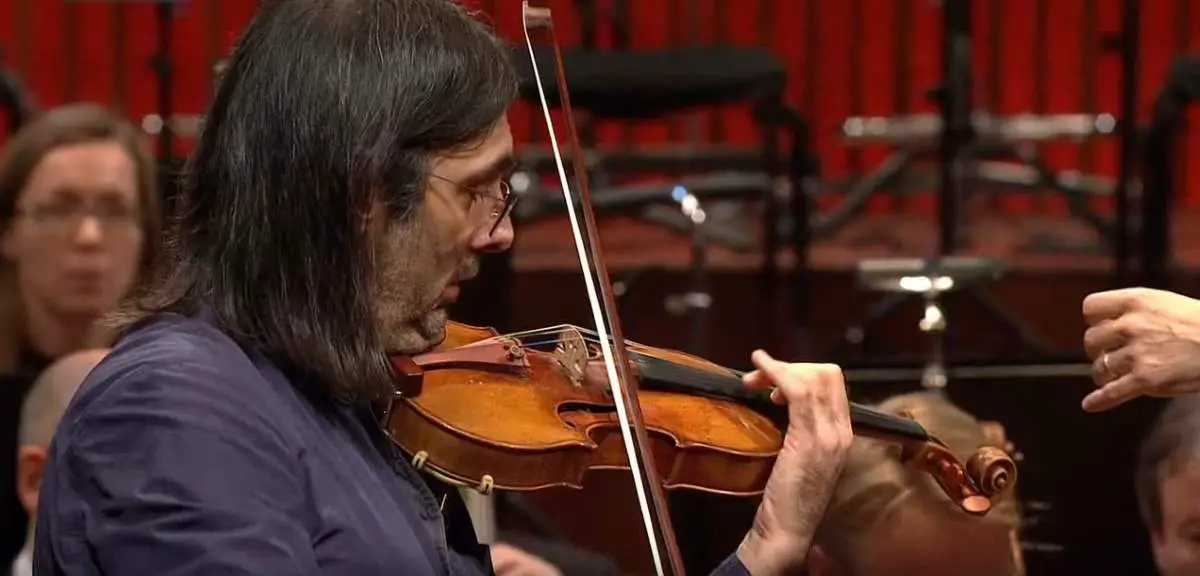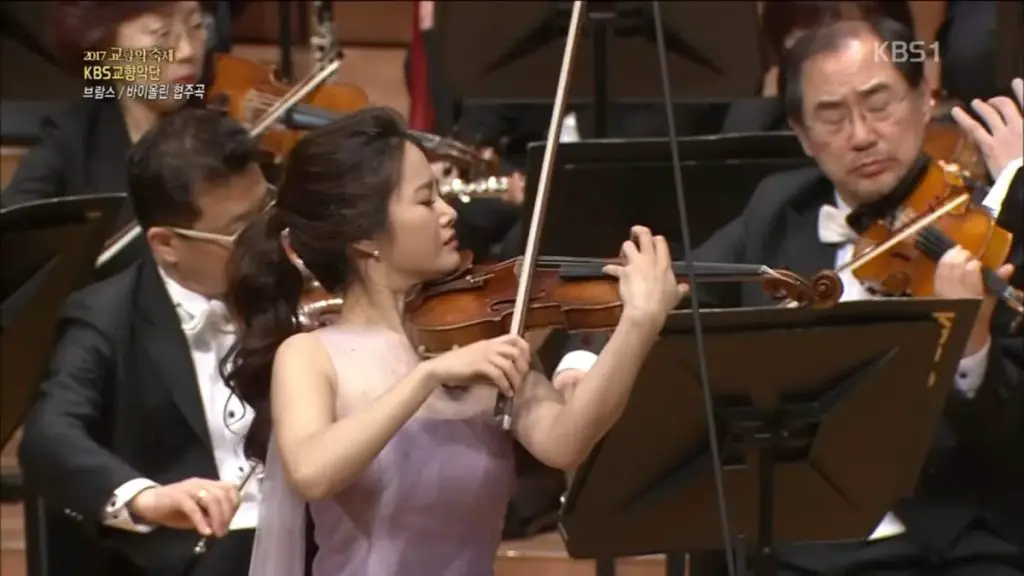Accompanied by the Chamber Orchestra of Europe, the Dutch classical violin concert and recording artist Janine Jansen performs Johannes Brahms’ Violin Concerto in D major, Op. 77 at Concertgebouw Amsterdam. Conductor: Bernard Haitink.
Johannes Brahms’ Violin Concerto
Johannes Brahms’ Violin Concerto in D major, Op. 77 is one of the cornerstones of the violin repertoire and a quintessential example of Romantic virtuosity and orchestral depth. Composed in 1878 during a productive summer in the Austrian town of Pörtschach am Wörthersee, this concerto stands as Brahms’ only violin concerto. He dedicated it to his close friend, the celebrated Hungarian violinist Joseph Joachim, who also provided valuable technical and artistic advice during its composition. Joachim’s influence ensured that the concerto was both musically compelling and idiomatic for the instrument.
Brahms’ concerto represents a unique synthesis of classical structure and Romantic expressiveness. While earlier Romantic composers like Mendelssohn and Bruch crafted violin concertos that prioritized melodic lyricism, Brahms brought a more symphonic and architectural approach. The orchestra plays a significant role, not merely as an accompanist but as an equal partner to the soloist, creating a dialogue that is rich and expansive. The concerto was initially met with mixed reactions, with some critics and audiences finding it too challenging and cerebral. However, over time, it has become renowned for its depth and complexity.
The violin writing in Brahms’ concerto is both demanding and expressive, requiring the soloist to navigate intricate passages and double stops while maintaining an overarching sense of lyricism. Unlike concertos designed purely to showcase virtuosity, Brahms’ work blends technical difficulty with profound musicality. This balance reflects Brahms’ meticulous craftsmanship and his deep understanding of the violin’s capabilities. The orchestration is lush and full-bodied, often weaving rich harmonies and counterpoint that complement the solo line rather than overshadow it.
Brahms’ approach to melody and structure in this concerto is particularly noteworthy. His themes are memorable and robust, yet they are developed with an intellectual rigor that avoids sentimentality. The dialogue between the soloist and orchestra unfolds organically, with motifs passing back and forth, evolving as the piece progresses. The concerto’s harmonic language reflects Brahms’ characteristic blend of warmth and introspection, often shifting between radiant, major-key passages and moments of deeper, more brooding intensity.
The premiere took place on January 1, 1879, in Leipzig, with Joseph Joachim as the soloist and Brahms himself conducting. Despite initial skepticism from some quarters, the concerto quickly gained recognition for its innovation and emotional power. Today, Brahms’ Violin Concerto is celebrated for its grandeur, demanding technical prowess, and the profound musical conversation it fosters between the soloist and orchestra.
Joseph Joachim told the guests at his 75th birthday party: “The Germans have four violin concertos. The greatest, most uncompromising is Beethoven’s. The one by Brahms vies with it in seriousness. The richest, the most seductive, was written by Max Bruch. But the most inward, the heart’s jewel, is Mendelssohn’s.”
Movements
1. Allegro non troppo (D major)
The first movement of Johannes Brahms’ Violin Concerto in D major, Op. 77 is marked “Allegro non troppo” and exemplifies the composer’s ability to merge classical form with Romantic expressiveness. This expansive movement is symphonic in scope, featuring a rich interplay between the solo violin and the orchestra. The movement opens with a lengthy orchestral introduction, a nod to Beethoven’s model in his own violin concerto. The orchestral strings and winds introduce the primary themes with a sense of grandeur, setting the stage for the violin’s entrance.
When the solo violin finally appears, it doesn’t simply repeat the themes but offers a more elaborate, virtuosic interpretation. The soloist’s entrance is bold and sweeping, characterized by double stops, arpeggios, and intricate runs. This approach demonstrates Brahms’ desire for the violin to serve as a dynamic voice within the orchestral framework rather than a mere showpiece. The movement’s main themes are both robust and lyrical, reflecting Brahms’ skill in balancing strength with tenderness.
The development section is particularly intense, with the solo violin and orchestra engaging in a rich dialogue. The harmonic exploration here showcases Brahms’ ability to shift between major and minor modes, adding layers of emotional depth. The interplay between soloist and orchestra becomes increasingly complex, with the violin line demanding both technical prowess and emotional nuance.
In the recapitulation, the themes return with added intensity and flourish. The movement concludes with a fiery cadenza, traditionally improvised by the soloist, though Brahms approved a cadenza written by Joseph Joachim. The cadenza serves as a dramatic climax before the orchestra rejoins to drive the movement to a powerful and satisfying close. This first movement is a masterful blend of structure, lyricism, and virtuosic display, setting a high standard for the remainder of the concerto.
2. Adagio (F major)
The second movement of Brahms’ Violin Concerto in D major, Op. 77, marked “Adagio”, is a serene and lyrical contrast to the grandeur of the first movement. Set in the key of F major, this movement is often praised for its warmth and delicate beauty. It opens with a gentle and richly expressive theme introduced by the oboe, one of Brahms’ most exquisite melodic creations. The oboe’s solo line is accompanied softly by the other woodwinds and strings, creating a tranquil, pastoral atmosphere that sets the tone for the entire movement.
When the violin enters, it takes up the oboe’s theme and embellishes it with graceful ornamentation. The soloist’s line is tender and introspective, requiring a sensitivity of tone and phrasing rather than virtuosity. Brahms employs a lush orchestral accompaniment, allowing the violin to float above the ensemble with a sense of poise and lyricism. This movement highlights Brahms’ gift for writing long, flowing lines that seem to unfurl effortlessly, offering a profound sense of calm and intimacy.
The interaction between the violin and the orchestra remains balanced, with the orchestral passages offering gentle support and occasional echoes of the soloist’s phrases. There is a subtle tension beneath the surface, with harmonies that briefly darken before resolving into the overarching serenity. The movement’s structure is simple and song-like, reminiscent of a Romantic aria, but Brahms’ harmonic shifts add emotional complexity.
As the movement progresses, the violin explores variations on the theme, often weaving through delicate, high-register passages. The orchestration remains restrained, ensuring that the violin’s lyrical voice remains the focus. The movement closes with a return to the tranquility of the opening, fading gently into a peaceful conclusion. This Adagio is widely regarded as one of the most heartfelt slow movements in the violin concerto repertoire, celebrated for its grace, warmth, and the profound dialogue between soloist and orchestra.
3. Allegro giocoso, ma non troppo vivace – Poco più presto (D major)
The third movement of Brahms’ Violin Concerto in D major, Op. 77, marked “Allegro giocoso, ma non troppo vivace – Poco più presto,” is a vibrant and spirited finale that bursts with energy and rhythmic vitality. Returning to the home key of D major, this movement stands in striking contrast to the contemplative Adagio that precedes it. The title “giocoso” (playful) aptly captures the exuberant, almost folk-like character of the music. Brahms infuses the movement with a sense of joy and robust vigor, reminiscent of Hungarian folk dances, a nod to the influence of the concerto’s dedicatee, Joseph Joachim, who was of Hungarian descent.
The solo violin introduces the main theme with a lively, syncopated rhythm, immediately engaging in a dynamic exchange with the orchestra. The rhythmic drive is relentless, with accents and off-beat patterns that give the music a playful, almost mischievous quality. The orchestra reinforces these rhythmic motifs, creating a vigorous and festive atmosphere. The interplay between the soloist and the ensemble is intricate, with the violin weaving dazzling runs, arpeggios, and double stops into the lively texture.
Throughout the movement, Brahms balances technical brilliance with musical substance. The violin part is virtuosic, demanding agility and precision, yet the music never descends into mere showmanship. Instead, Brahms maintains a sense of structural integrity and thematic development. The harmonic progressions add a layer of sophistication, with occasional shifts to minor keys that introduce a brief sense of tension before returning to the buoyant, major-key exuberance.
As the movement progresses, the music builds in intensity, culminating in the “Poco più presto” section, where the tempo quickens, driving toward a jubilant conclusion. The finale ends with a flourish, as the soloist and orchestra join forces for a spirited and triumphant finish. This movement serves as a joyful and exhilarating conclusion to the concerto, combining Brahms’ craftsmanship with a sense of rhythmic freedom and festive energy.
Sources
- Violin Concerto (Brahms) on Wikipedia
- Violin Concerto, Op.77 (Brahms, Johannes) on the International Music Score Library Project website


